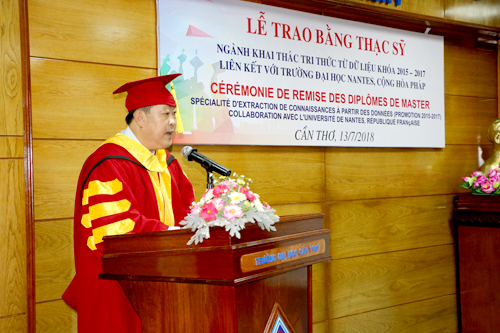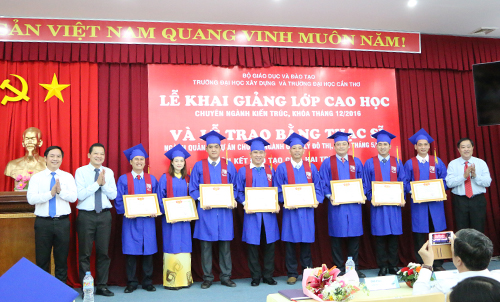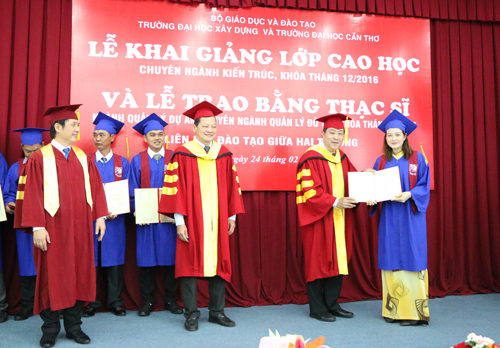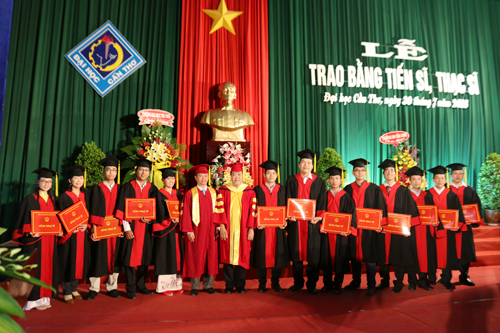
Tên đề tài: Nghiên cứu nâng cao hàm lượng các thành phần chức năng trong sản xuất gạo nảy mầm và chế biến thử nghiệm bột dinh dưỡng gạo mầm
Tác giả: Phạm Quang Trung, Khóa: 2014
Chuyên ngành: Công nghệ thực phẩm; Mã số: 62540101. Nhóm ngành: Công nghệ sản xuất và chế biến
Người hướng dẫn chính: PGS.TS. Nguyễn Công Hà - Trường Đại học Cần Thơ.
Người hướng dẫn phụ: PGS.TS. Lê Nguyễn Đoan Duy - Trường Đại học Công nghiệp Thực phẩm TP HCM.
- Tóm tắt nội dung luận án:
Để tạo bước đi mới trong công nghệ chế biến các sản phẩm cao cấp, chất lượng từ gạo, gạo mầm cần nghiên cứu chọn lựa giống lúa thích hợp từ nguồn lúa gạo dồi dào ở ĐBSCL cho việc sản xuất gạo mầm, nghiên cứu các giải pháp công nghệ nâng cao hàm lượng GABA (γ-amino butyric acid) và các thành phần chức năng khác trong quá trình sản xuất gạo mầm cũng như các sản phẩm thực phẩm từ gạo mầm cần được thực hiện. Nghiên cứu đã khảo sát các yếu tố ảnh ưởng đến khả năng sinh tổng hợp các thành phần chức năng trong sản xuất gạo lứt nảy mầm đặc biệt là GABA từ đó chọn ra thông số thích hợp giúp nâng cao hàm lượng của các thành phần chức năng; chọn được giống lúa thích hợp và hoàn thiện được quy trình chế biến và bảo quản sản phẩm bột gạo mầm; cải thiện những vấn đề còn tồn tại đối với quy trình chế biến và bảo quản các sản phẩm có giá trị gia tăng từ gạo mầm đặc biệt là hạn chế các quá trình oxi hóa chất béo trong sản xuất bột gạo mầm rang; đánh giá được tính hiệu quả của bột gạo mầm dinh dưỡng (rang) khi thử nghiệm in vitro trên tế bào HepG2 cell và in vivo trên chuột mắc bệnh đái tháo đường.
Vì vậy, nghiên cứu nâng cao hàm lượng các thành phần chức năng trong sản xuất gạo nảy mầm và chế biến thử nghiệm bột dinh dưỡng gạo mầm đã được thực hiện với bốn nội dung bao gồm: (1) Nội dung 1: Xác định một số giống lúa thích hợp dùng trong sản xuất gạo mầm có hàm lượng dinh dưỡng và giá trị chức năng cao, (2) Nội dung 2: xây dựng quy trình nâng cao khả năng sinh tổng hợp những thành phần chức năng khác trong quá trình nảy mầm; (3) Nội dung 3: xây dựng quy trình chế biến và bảo quản sản phẩm bột gạo mầm uống liền thật sự có hiệu quả về mặt dinh dưỡng và chức năng; (4) Nội dung4: nghiên cứu thử nghiệm tác động của sản phẩm bột gạo mầm chức năng (rang) in vitro (thử khả năng kháng tế bào ung thư gan HepG2 cell) và in vivo (trên chuột mắc bệnh đái tháo đường).
Sau quá trình thực hiện, nghiên cứu đã ghi nhận các kết quả như sau: Nội dung 1: IR 50404 là giống lúa được tuyển chọn. Gạo lức được ngâm trong dung dịch acid glutamic 0,6% (ở giá trị pH bằng 3) trong 6 giờ được lựa chọn với hàm lượng GABA đạt 141,94mg/kg chất khô. Ngoài ra, CaCl2 không ảnh hưởng đến quá trình sinh GABA; (2) Nội dung 2: Gạo lức sau ngâm được ủ ở 37°C trong 28 giờ với độ dày lớp hạt 0,9 cm và số vỉ là 30 cho kết quả phù hợp nhất, có hàm lượng GABA đạt 269,23 mg/kg. Gạo mầm được sấy ở 65°C trong 3 giờ và được bảo quản bằng bao bì PA hút chân không cho chất lượng tốt nhất; (3) Nội dung 3: Nhiệt độ rang 200°C trong thời gian 30 phút là điều kiện rang tốt nhất với sản phẩm bột gạo mầm rang (xét về giá trị cảm quan và hàm lượng GABA) ở mẻ thí nghiệm 100 gram. Gạo mầm được bổ sung 10% (w/w) dịch chiết nấm kim châm giúp duy trì chất lượng bột ổn định sau 4 tháng bảo quản và không có sự khác biệt về chất lượng ở bao bì PA và bao bì Nhôm (có hút chân không); (4) Nội dung 4: Bột gạo mầm rang được trích ly bằng nước cất với tỷ lệ 1:7 (w/v), thời gian 10 phút và nhiệt độ 80°C được lựa chọn. Vì vậy, khi sử dụng sản phẩm cần được pha với nước ấm 70-80°C để đạt hiệu quả tốt nhất. Kết quả cũng chỉ ra rằng bột gạo mầm rang có khả năng ức chế sự phát triển của tế bào ung thư gan đạt 31-38%. Tuy nhiên, sản phẩm này chưa mang lại hiệu quả trong điều trị bệnh đái tháo đường. Qua nghiên cứu cho thấy, gạo lức sau khi được nảy mầm ở điều kiện thích hợp giúp nâng cao hàm lượng các thành phần chức năng, đồng thời gạo mầm sau khi chế biến thành bột rang, giúp tăng giá trị cảm quan và có khả năng ức chế tế bào ung thư gan đạt khoảng 38% nhưng chưa cho thấy hiệu quả trong điều trị bệnh đái tháo đường.
- Những kết quả mới của luận án:
Chọn được giống lúa thích hợp từ các giống phổ biến ở ĐBSCL để chế biến gạo mầm
Gạo mầm được sản xuất thử nghiệm và khảo sát ở quy mô pilot
Sản phẩm bột gạo mầm rang được thực nghiệm in vitro và in vivo để chỉ rõ khả năng dinh dưỡng và chức năng.
Sử dụng dịch trích nấm kim châm chứa chất chống oxy hóa tự nhiên (ergothioneine) hỗ trợ hiệu quả cho việc hạn chế oxy hóa lipid và duy trì chất lượng sản phẩm theo thời gian bảo quản.
- Các ứng dụng/khả năng ứng dụng trong thực tiễn, các vấn đề cần tiếp tục nghiên cứu:
Nghiên cứu đã xây dựng hoàn thiện quy trình công nghệ chế biến và bảo quản bột gạo mầm rang góp phần tạo ra thêm sản phẩm mới cho ngành sản xuất thực phẩm có giá trị gia tăng, thực phẩm chức năng phục vụ nhu cầu phát triển bền vững sản xuất nông nghiệp, có thể áp dụng ở quy mô hộ gia đình, doanh nghiệp vừa và nhỏ. Kết quả này góp phần nâng cao giá trị của cây lúa (cụ thể là giống IR 50404) thông qua sản phẩm giá trị gia tăng của nó. Nghiên cứu đáp ứng nhu cầu phát triển thực tiễn của ngành sản xuất thực phẩm có giá trị gia tăng, thực phẩm chức năng phục vụ nhu cầu phát triển bền vững sản xuất nông nghiệp, công nghiệp liên quan tại ĐBSCL.
Tuy nhiên, cần thực hiện một số khảo sát làm cơ sở cho việc phát triển sản phẩm với quy mô công nghiệp, cụ thể như sau:
- Phát triển thêm các sản phẩm chế biến từ gạo mầm.
- Nghiên cứu phối trộn gạo mầm với một số hạt ngũ cốc khác trong chế biến bột gạo mầm rang.
- Nghiên cứu đánh giá tác động của sản phẩm bột gạo mầm rang trên một số tế bào khác.
- Nghiên cứu đánh giá tác động của sản phẩm bột gạo mầm rang đối với bệnh béo phì.
Thesis title: Research improving the content of functional compounds in production of germinated brown rice and processing of nutritional flour from germinated brown rice.
Specialization: Food Technology Code: 9.54.01.01
Full name of PhD student: Pham Quang Trung
Science Instructor: PGs.Ts. Nguyen Cong Ha, PGs.Ts. Le Nguyen Doan Duy
Training institution: Can Tho University
- Summary of thesis content:
In order to create a new step in the technology of processing high-quality and high-quality products from rice, it is necessary to research and select suitable rice varieties from the abundant rice source in the Mekong Delta for the production of germ rice, research on Technological solutions to improve the content of GABA (γ-amino butyric acid) and other functional components in the production of germ rice as well as food products from sprouted rice need to be implemented. The study investigated the factors affecting the biosynthesis of functional components in the production of germinated brown rice, especially GABA, from which to select the appropriate parameters to help improve the content of these functional components. power; select suitable rice varieties and perfect the process of processing and preserving germ rice flour products; improve the existing problems for the processing and preservation of value-added products from sprouted rice, especially limiting the fat oxidation processes in the production of roasted sprouted rice flour; evaluated the effectiveness of nutritional rice germ powder (roasted) when tested in vitro on HepG2 cells and in vivo in diabetic mice.
Therefore, research on improving the content of functional ingredients in germinated rice production and experimental processing of sprouted rice nutritional powder has been carried out with four contents. The content 1 which determined some rice varieties suitable for the production of GBR with high nutritional content and functional value. Nextly, the content 2 which contributed a process to improve the biosynthesis of other functional components in germination process. Continuosly, the content 3 which contributed the process of processing and preserving instant rice germ powder products that are really effective in terms of nutrition and function. Finally, the content 4 which studied and tested the effects of functional rice flour (roasted) product in vitro (testing against HepG2 cell) and in vivo (on diabetic mice).
After the completed contents, the study has recorded the following results: Content 1: IR 50404 is selected rice variety. The soaking brown rice in buffer solution added 0.6% glutamic acid (at pH value of 3) for 6 hours was selected with GABA content of 141.94 mg/kg dry matter. In addition, CaCl2 did not affect on GABA generation; Content 2: Brown rice after soaking was incubated at 37°C for 28 hours with a grain thickness of 0.9 cm and number of blisters of 30 giving the most suitable result, with GABA content of 269.23 mg/kg. The GBR was dried at 65°C for 3 hours and preserved with PA vacuum packaging for the best quality; Content 3: Roasting temperature of 200°C in 30 minutes was the best roasting condition for roasted germinated rice products (in terms of sensory value and GABA content) in the 100 gram test batch. The GBR is supplemented with 10% (w/w) of Flammulina velutipes extract helped to maintain a stable quality of powder after 4 months of storage. and there is no difference in quality between PA and Aluminum packaging (with vacuum packaging); Content 4: The roasted GBR powder was extracted with distilled water at the rate of 1:7 (w/v), in 10 minutes and temperature of 80°C was selected. Therefore, when using the product, it should be mixed with warm water of 70-80°C for the best effect. The results indicated that roasted germinated brown rice flour has the ability to inhibit the growth of liver cancer cells by 31-38%. However, this product has not been effective in treating diabetes. Through research shows that brown rice, after being sprouted in the right conditions, helps to increase the content of functional components, while germinated rice, after being processed into roasted flour, increases the sensory value and is capable of the ability to inhibit liver cancer cells is about 38%, but it has not been shown to be effective in diabetes treatment.
- New results of the thesis:
Selecting suitable rice varieties from popular varieties in the Mekong Delta to process germ rice.
Germinated brown rice is produced in trial and survey at a pilot scale.
Roasted sprouted rice flour product has been tested in vitro and in vivo to show its nutritional and functional capabilities.
Using shiitake mushroom extract containing natural antioxidants (ergothioneine) effectively supports the limitation of lipid oxidation and maintains product quality over time of storage.
- Practical applications/applicability, issues that need further research:
The research has perfected the technological process of processing and preserving roasted sprouted rice flour, contributing to creating more new products for the food manufacturing industry with added value and functional foods to serve the development needs, sustainable agricultural production, can be applied at household scale, small and medium enterprises. This result contributes to improving the value of rice (specifically IR 50404) through its value-added product. Research to meet the practical development needs of the value-added food production industry, functional foods to serve the needs of sustainable development of agricultural and related industrial production in the Mekong Delta.
However, it is necessary to carry out some surveys as a basis for product development on an industrial scale, specifically as follows:
- Developing more products processed from sprouted rice.
- Research on mixing sprouted rice with some other grains in the processing of roasted sprouted rice flour.
- Research to evaluate the effects of roasted sprouted rice flour on some other cells.
- Studying evaluate the impact of roasted sprouted rice flour products on obesity.
- Xem chi tiết nội dung luận án
- Xem thông tin đăng tải tại Website Bộ giáo dục và Đào tạo. (Nhập tên NCS vào ô tìm kiếm)




















